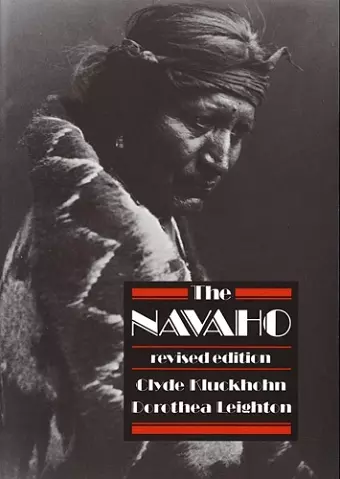The Navaho
Revised Edition
Clyde Kluckhohn author Dorothea C Leighton author Lucy Wales Kluckhohn editor Richard Kluckhohn editor
Format:Paperback
Publisher:Harvard University Press
Published:31st Jan '92
Currently unavailable, and unfortunately no date known when it will be back

What are the Navaho today? How do they live together and with other races? What is their philosophy of life? Both the general reader and the student will look to this authoritative study for the answers to such questions. The authors review Navaho history from archaeological times to the present, and then present Navaho life today. They show the people’s problems in coping with their physical environment; their social life among their own people; their contacts with whites and other Indians and especially with the Government; their economy; their religious beliefs and practices; their language and the problems this raises in their education and their relationships to whites; and their explicit and implicit philosophy.
This book presents not only a study of Navaho life, however: it is an impartial discussion of an interesting experiment in Government administration of a dependent people, a discussion which is significant for contemporary problems of a wider scope; colonial questions; the whole issue of the contact of different races and peoples. It will appeal to every one interested in the Indians, in the Southwest, in anthropology, in sociology, and to many general readers.
This work forms the most thoroughgoing study ever made of the Navaho Indians, and perhaps of any Indian group. The book was written as a part of the Indian Education Research Project undertaken jointly by the Committee on Human Development of the University of Chicago and the United States Office of Indian Affairs. The cooperation of a psychiatrist and anthropologist both in the research for, and in the writing of, this study is noteworthy—as is the fusion of methods and points of view derived from medicine, psychology, and anthropology. Probably no anthropological study has ever been based upon so many years of field work by so many different persons.
This collaboration between an anthropologist and a medico-psychiatrist has been a fortunate one. Professor Kluckhohn and Dr. Leighton have tried, as social scientists, to show the Navaho points of view, and then show how the Army, the missionary, the trader, the Indian Bureau, the white rancher or farmer surrounded the Navaho with new standards of ethical judgment and social procedure. The result was to frustrate much in the Navaho that had produced a sense of security and well-being… This book teaches the salutary lesson that majority culture patterns are not self-justifying… If we have achieved a greater mastery over the forces of nature than the Navahos, perhaps they have received more by experiencing the beauty and emotional values in nature than we. -- Anne Richards * New York Times *
This book is one of a series of tribal monographs published on behalf of an Indian Education Research Project sponsored by the University of Chicago and the U.S. Office of Indian Affairs… The deep concern of the authors for the welfare of the Navajos is shown by it and other books which they have written, and it is a useful, though necessarily limited, study of culture contact, based on intimate knowledge… The production of the book is up to high standard which we expect of the Harvard University Press, and it is illustrated by some admirable photographs. -- G. H. S. Bushnell * Nature *
This book is one of the most successful efforts so far to communicate the results of the anthropological study of one people to another people…the book is not addressed to the specialist in the study of culture… Without resort to dramatization or oversimplification, [it] should communicate to many kinds of American readers the goals and viewpoints of the Navahos. * Annals of the American Academy *
The book is so sympathetic and unbiased that anyone can approximately realize the problems that have harassed these people for years, and that have stood between them and those who surround them, the predatory whites as well as those who honestly attempt to reorganize their economic system without understanding its workability. -- Mabel Dodge Luhan * Chicago Sun *
The Navaho is one of a projected series of studies of Indian tribes designed to get at the real grassroots needs of improving the relationship of Indian and white, in both government and private spheres of activity… After a compact résumé of the tribe’s history, both known and surmised from archaeology and mythology, the material background of the people is discussed in a chapter called ‘Land and Livelihood.’ Here are demographies, economics, technology, arts and crafts and their relation to the Americans through the government and the trader… Then comes the life of the tribe in its own frame… Three chapters concern that aspect of Navaho life which we call religious, basically its relation to the supernatural. Here both the details of material practice and the analysis of abstract thoughts are given, as well as discussions of the relationships of these concepts and customs to the individual, the group, and the outer world through economic and social aspects. -- F. H. Douglas * Folklore and Folklorists *
Although intended primarily as background reading for teachers and administrators in the Navajo Service, this book should have a special appeal for all Southwestern readers. Family life, social prejudices and ideal, religious preoccupations, as well as the daily struggle for livelihood, are described in terms which indicate why many of these cultural features unwittingly and inevitably prove stumbling blocks to an administrative service which seeks only to improve their health and economy… In short, this is a book of interpretation; the authors serve as translators of culture between the Navajo and the Indian Service, and any intelligent reader should achieve a new and sympathetic attitude toward both well-meaning and baffled factions. -- A. H. Gayton * New Mexico Historical Review *
ISBN: 9780674606036
Dimensions: unknown
Weight: 417g
374 pages
2nd Revised edition